
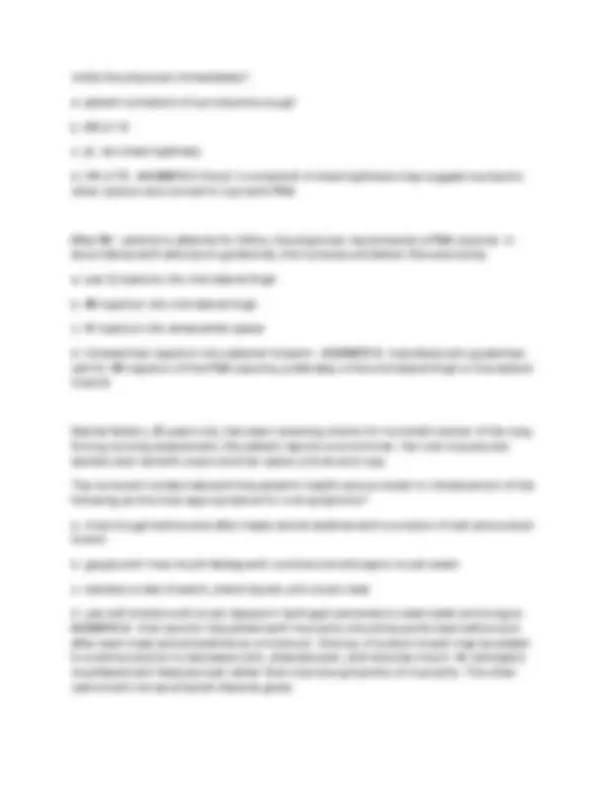
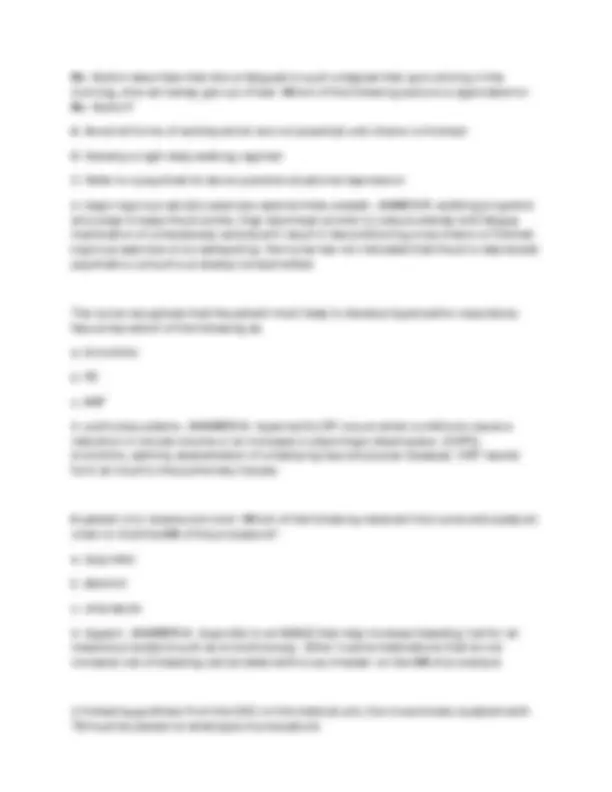
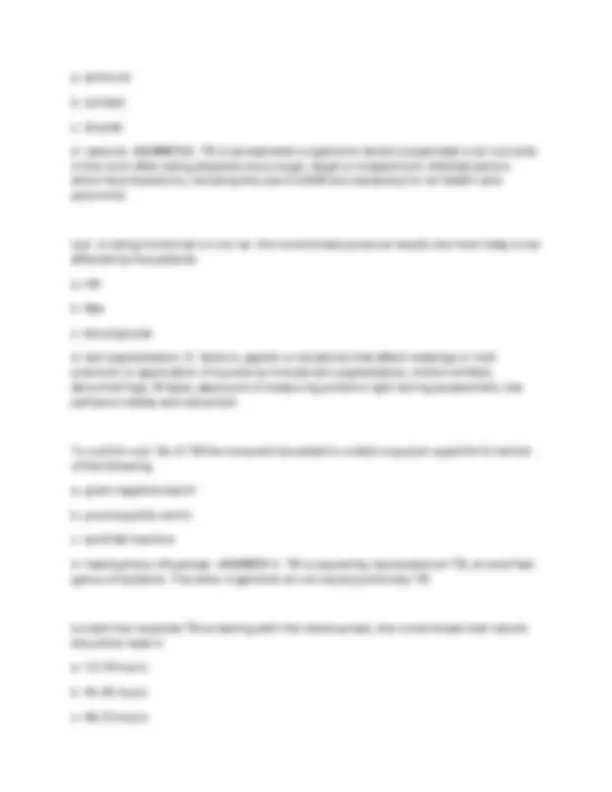
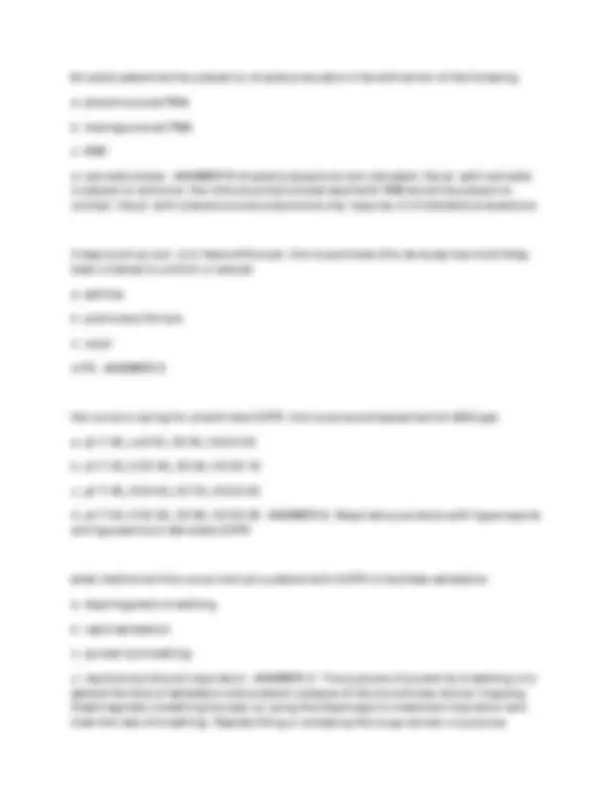
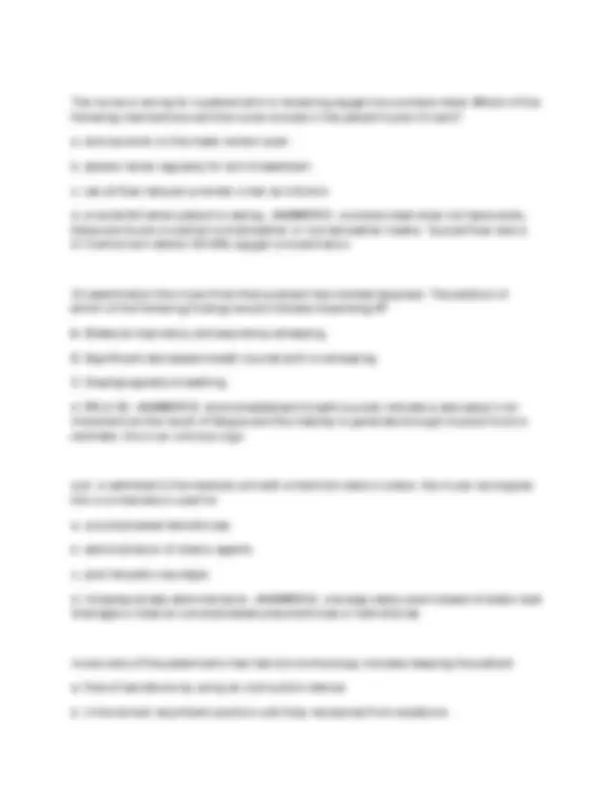
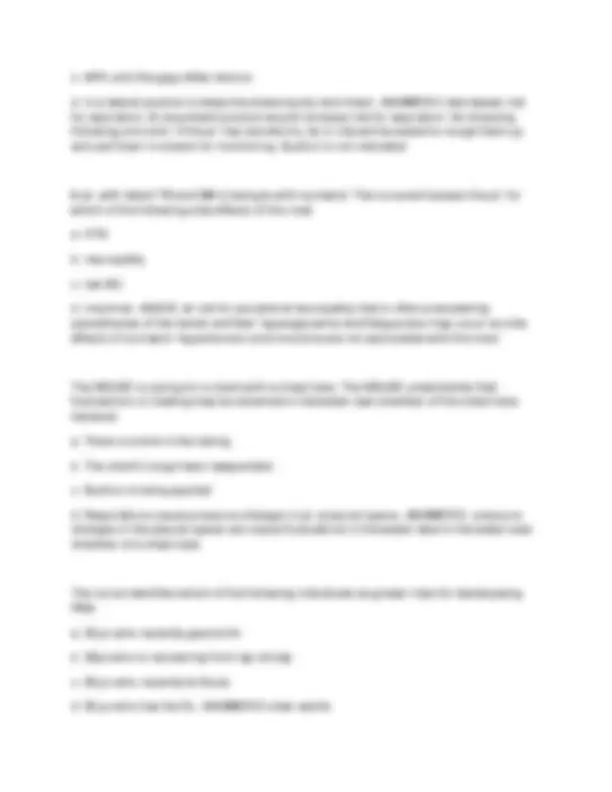
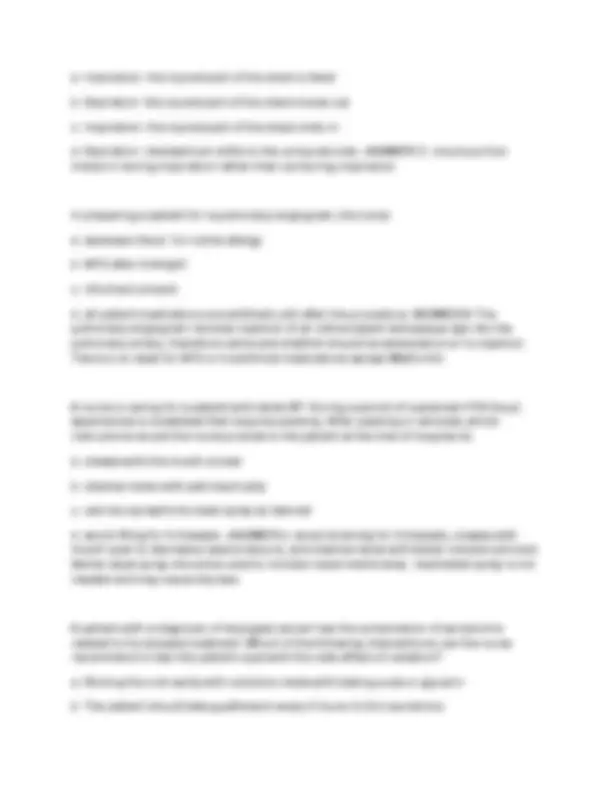
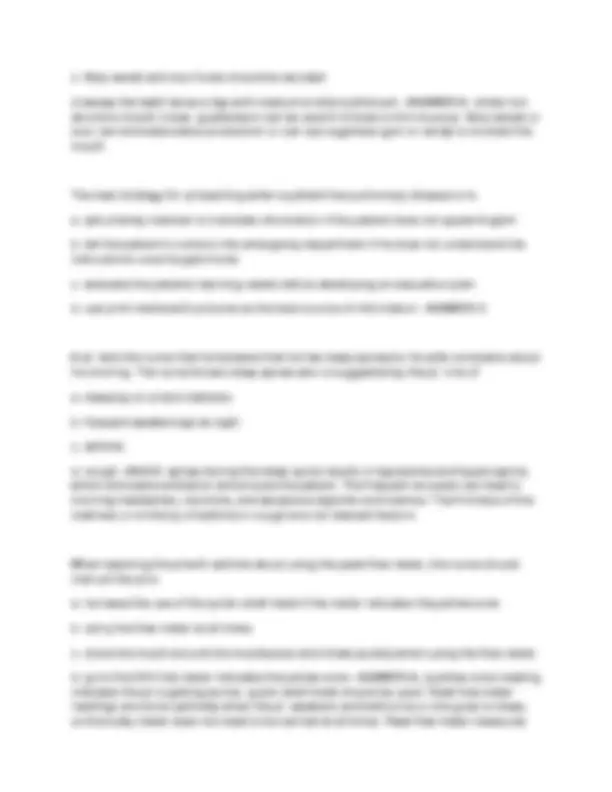
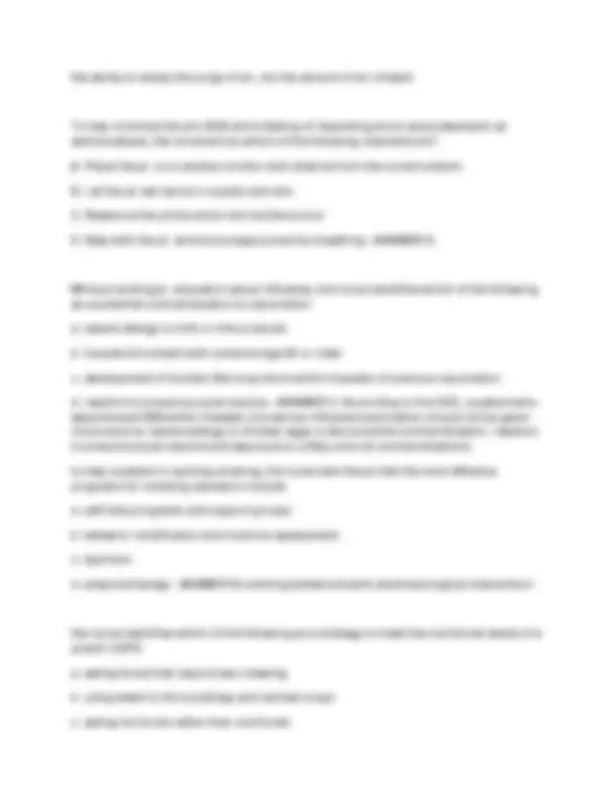

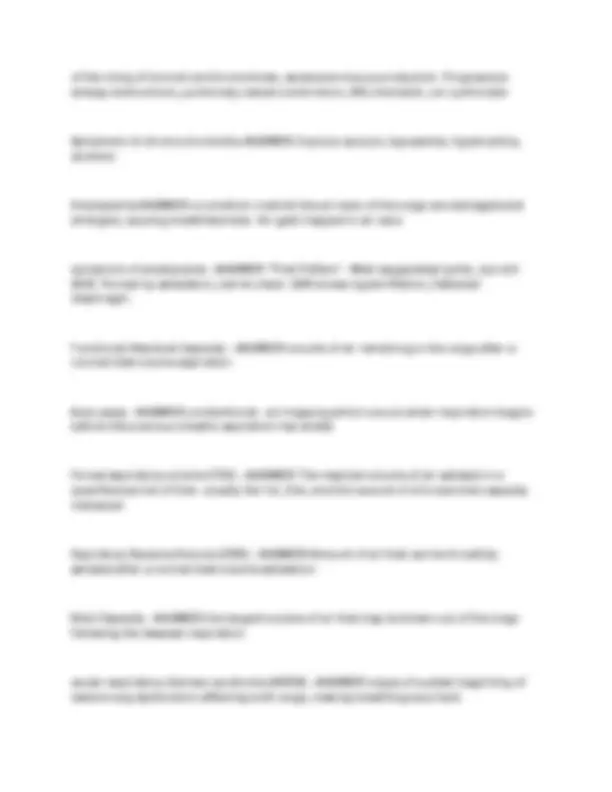
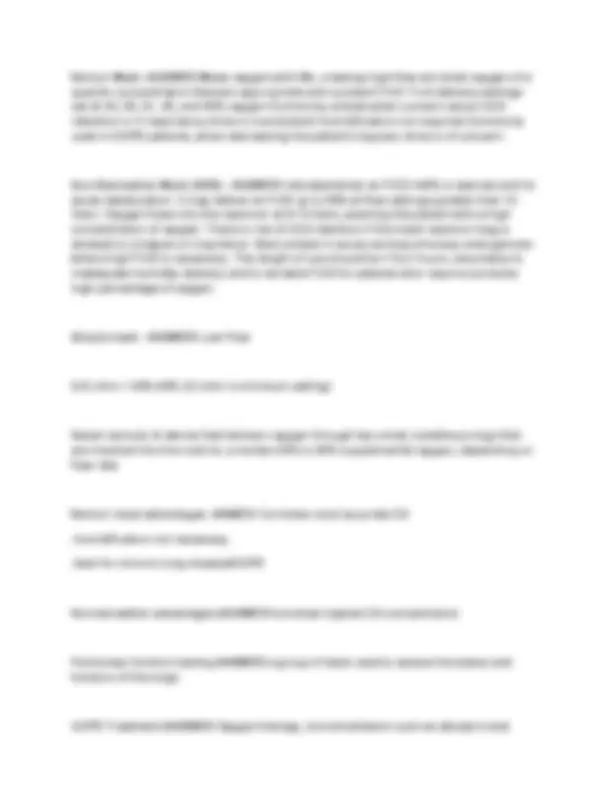
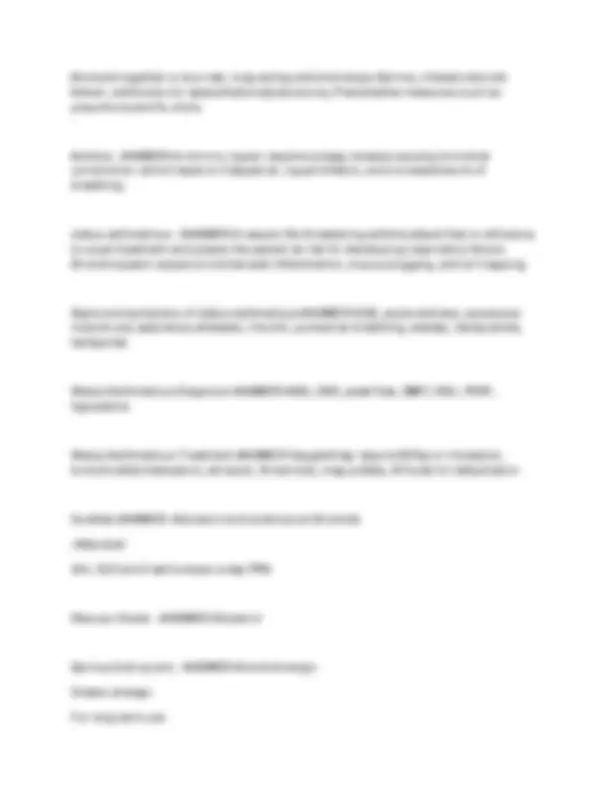
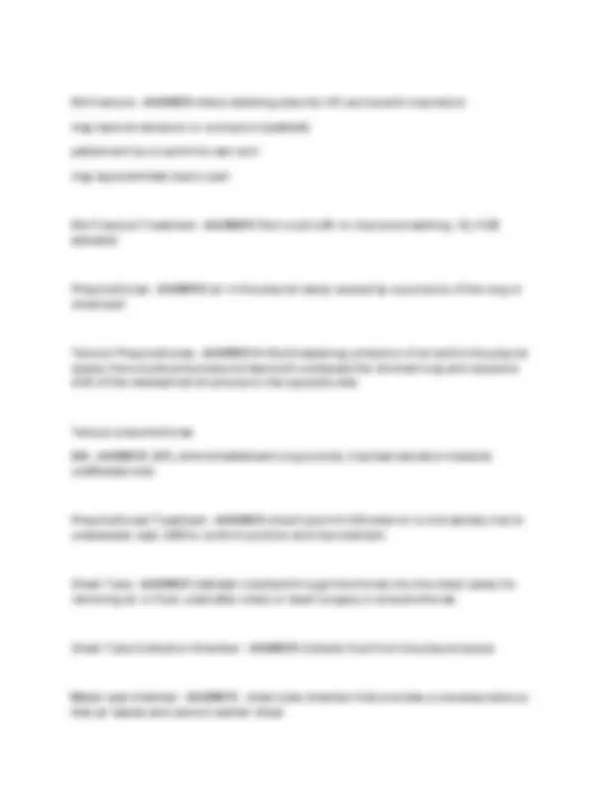
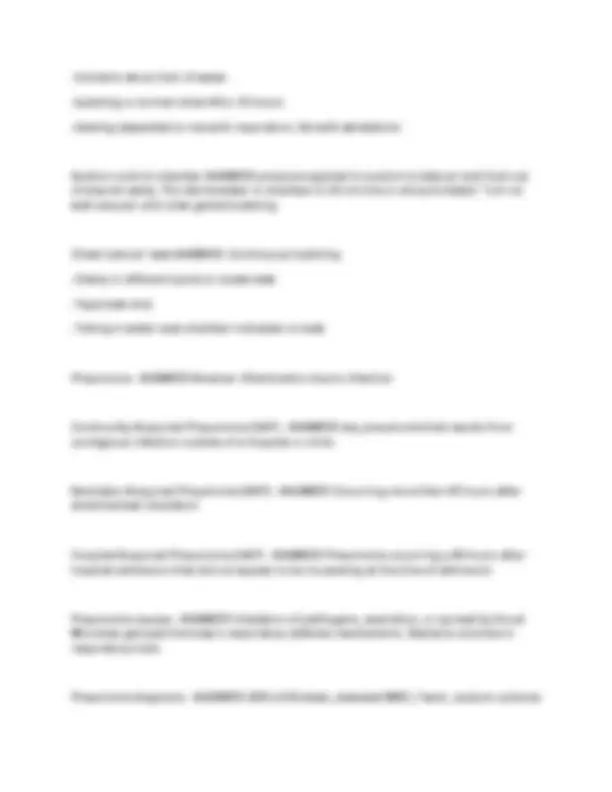
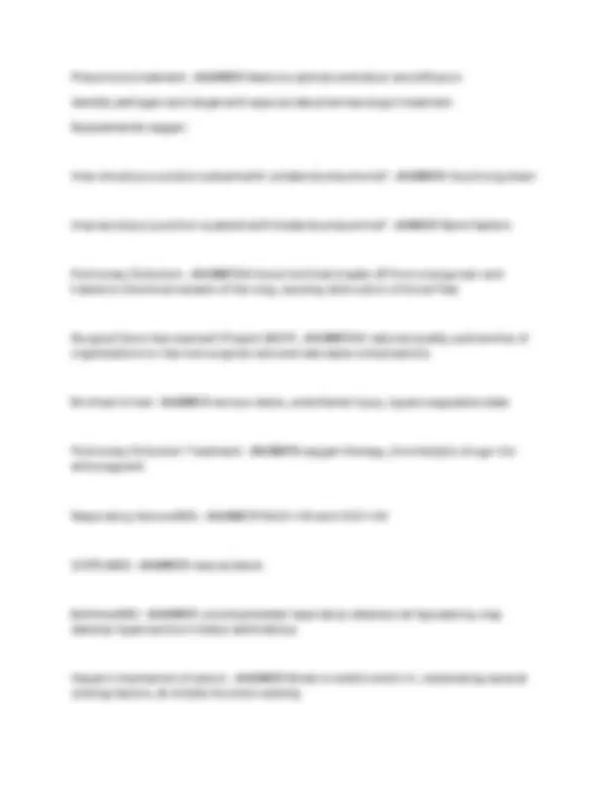
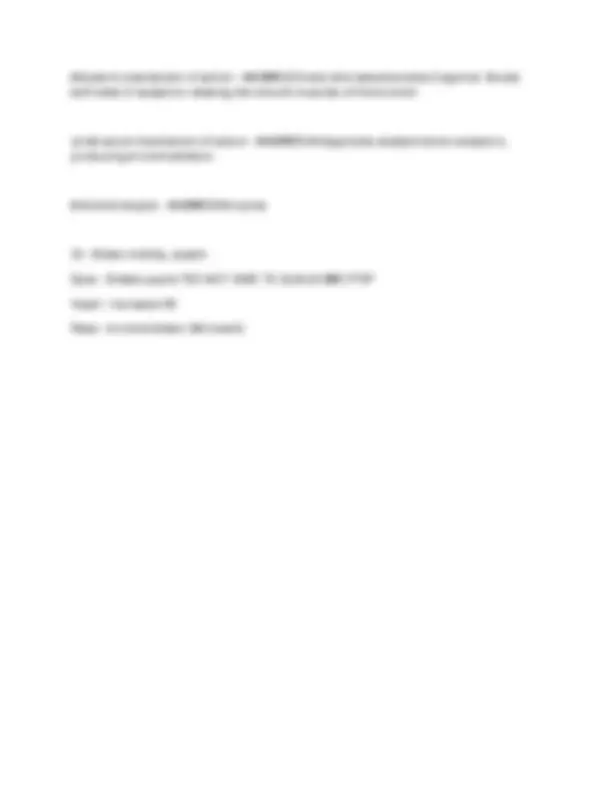


Study with the several resources on Docsity

Earn points by helping other students or get them with a premium plan


Prepare for your exams
Study with the several resources on Docsity

Earn points to download
Earn points by helping other students or get them with a premium plan
Community
Ask the community for help and clear up your study doubts
Discover the best universities in your country according to Docsity users
Free resources
Download our free guides on studying techniques, anxiety management strategies, and thesis advice from Docsity tutors
A valuable resource for healthcare students and professionals preparing for pulmonary exams. it features a series of multiple-choice questions covering various aspects of pulmonary health, including tuberculosis, sleep apnea, pneumonia, and asthma management. Each question is accompanied by a detailed explanation of the correct answer, enhancing understanding and knowledge retention. This resource is particularly useful for those seeking to improve their diagnostic and treatment skills in respiratory care.
Typology: Exams
1 / 25

This page cannot be seen from the preview
Don't miss anything!


















During the admission assessment at the hospital, the nurse identifies that the following puts the patient at risk for TB
The nurse is assessing findings of the TB skin test performed with purified protein derivative. For which of the following clients would the nurse identify a positive reaction if there is a response of 5mm induration?
anyone who has moved within the last 5 years from a country with prevalence of TB would have a positive response with induration 10mm or more. for persons at low risk for TB a positive response is noted with induration of 15mm or more
A patient is newly diagnosed with mild obstructive sleep apnea and asks the nurse if he can make lifestyle changes to improve his condition. Which of the following changes does the nurse identify as contributing to improvement in symptoms?
The patient is frustrated because she cannot tolerate the mask for her tx with CPAP. Based on which of the following reasons does the nurse believe that this patient will be more tolerant of BiPAP tx? 1. Lower inspiratory pressure and higher expiratory pressure can be used. 2. Bipap provides symptom relief 3. Higher inspiratory pressure and lower expiratory pressure can be used
in screening a 72 yo to recieve influenza and pneumonia vaccines, the nruse determines both vaccines are indicated. what would be the correct action by the nurse
James Cantrell, age 82 is admitted to the medical unit with a dx of bacterial pneumona. Treatment is initiated with IV Keflex 400 mg every 12 hours.
The Nurse knows Mr. Cantrell's risk for developing the PNA was increased because admission assessment revealed he also: a. is homebound b. has DM c. is African American d. has a stage 2 decub ulcer ANSWER B Risk factors for CAP include diabetes, cardiovascular disorders, alcohol abuse, and immunosuppression. The other options do not significantly contribute to PNA risk.
James Cantrell, 82 years of age, is admitted to the medical unit with a diagnosis of bacterial pneumonia. He is started on IV Keflex 400 mg every 12 hours.
Mr. Cantrell develops a pleural effusion that impairs his respiratory functioning. The physician performs a thoracentesis in the special procedures area and the patient is returned to his room. Which of the following postprocedure symptoms would the nurse
Ms. Sutton describes that she is fatigued to such a degree that upon arising in the morning, she can barely get out of bed. Which of the following actions is applicable for Ms. Sutton?
A. Avoid all forms of activity which are not essential until chemo is finished
B. Develop a light daily walking regimen
C. Refer to a psychiatrist about possible situational depression
d. begin vigorous aerobic exercise several times a week - ANWER B. walking programs are a way to keep the pt active. they have been proven to reduce anxiety and fatigue. Inactivation of unnecessary activity will result in deconditioning once chemo is finished. vigorous exercise is too exhausting. the nurse has not indicated that the pt is depressed psychiatric consult is probably not warranted
The nurse recognizes that the patient most likely to develop hypercarbic respiratory failure has which of the following dx.
a. bronchitis
b. PE
c. ARF
d. pulmonary edema - ANSWER A. hypercarbic RF occurs when conditions cause a reduction in minute volume or an increase in physiologic dead space. (COPD, bronchitis, asthma, exacerbation of underlying neuromuscular disease). HRF results form an insult to the pulmonary tissues.
A patient is to receive a bronch. Which of the following meds will the nurse anticipate an order to hold the AM of the procedure?
a. ibuprofen
b. atenolol
c. omprazole
d. digoxin - ANSWER A. ibuprofen is an NSAID that may increase bleeding risk for an invasive procedure such as bronchoscopy. Other routine medications that do not increase risk of bleeding can be taken with a sip of water on the AM of procedure
in following guidlines from the CDC on the medical unit, the nruse knows a patient with TB must be placed on what type of precuations
a. airborne
b. contact
c. droplet
d. reverse - ANSWER A. TB is spread when organisms remain suspended in air currents in the room after being disperse via a cough, laugh or sneeze from infected person. airborne precautions, including the use of a N95 are necessary for all health care personnel
a pt. is being monitored on con ox. the nurse knows pulse ox results are most likely to be affected by the patients
a. HR
b. Sex
c. blood gluose
d. skin pigmentation- D. factors, agents or situations that affect readings or limit precision or application of a pulse ox include skin pigmentation, motion artifact, abnormal Hgb, IV dyes, exposure of measuring probe to light during assessment, low perfusion states and nail polish
To confirm a pt. Dx of TB the nurse will be asked to collect a sputum specifim for which of the following
a. gram negative bacilli
b. pnumocystits carinii
c. acid fast bacillus
d. haemophilus influenzae - ANSWER C. TB is caused by myobacterium TB, an acid fast genus of bacteria. The other organisms do not cause pulmonary TB.
a client has received TB screening with the mantoux test, the nurse knows test results should be read in
a. 12-18 hours
b. 24-36 hours
c. 48-72 hours
d. osteopenia - ANSWER D. BC people with CF can have nutrient malabsorption resulting in low bone mineral content, they are at risk for osteopenia
The nurse is providing education for the use of triamcinolone INH for long-term management of asthma. Which of the following would the nurse identify as the most likely complication of the use of this type of medication? A) Increased bronchial secretions B) Rebound nasal congestion C) Hoarseness
d. epistaxis - ANSWER C. use of INH corticosteroids may cause hoarseness, dry mouth and oral candidiasis. Increased bronchial secretions may result from use of expectorants such as guifenesin while rebound congestion and epistaxis can occur with nasal decongestants such as phenylephrine
The nurse is caring for a 38yo pt with dx of emphysema. The nurse knows the patient also should be assessed for which of the following conditions
a. alpha-antitrypsin deficiency
b. CF
c. DM
d. tay sachs disease - ANSWER .a. alpha-anti trypsin deficinency is a known genetic abnormality that leads to COPD. a pt. dx with emphysema before 40 should be assessed for this condition
The nurse is evaluation results of TB skin with purified protein derivative. the nurse will recognize which of the following statements as corrects regarding PPD testing
a. immunocompromised pt cannot receive injection
b. Those patients who have received the immunization of bacille Calmette Guerin may result in false-positive results.
c. 0-4mm results are considered a negative response and exclude TB infection.
d. measurements, in millimeters, of the area of redness will determine the patient's response to the injection. -ANSWER B. A false-positive response to PPD testing can occur for many years post-vaccination with BCG. An immunocompromised patient can receive PPD testing but may have false-negative results. A result of 0-4 mm, although it is a negative response, does not rule out infection with TB. The response is determined based on the measurement of the area of induration, not the area of redness.
An adult patient will be placed on droplet precuation if dx with which of the following
a. pneumococcal PNA
b. meningococcal PNA
c. RSV
d. varicella zoster - ANSWER B droplet precautions are indicated. the pt. with varicella is placed on airborne. the immunocompromised adult with RSV would be placed on contact. the pt. with pneumococcal pneumonia only requires of of standard precautions
2 days post op a pt. is to have a VQ scan. the nruse knows this dx study has most likley been ordered to confirm or exlude
a. asthma
b. pulmonary fibrosis
c. copd
d.PE - ANSWER D
the nurse is caring for pt with late COPD. the nurse would expect which ABG gas
a. ph 7.25, co2 60, O2 60, HCO3 30
b. ph 7.30, CO2 45, O2 60, HCO3 18
c. ph 7.45, CO2 40, O2 75, HCO3 26
d. ph 7.50, CO2 30, O2 80, HCO3 35 - ANSWER A. Respiratory acidosis with hypercapnia and hypoxemia is late state COPD
what method will the nurse instruct a patient with COPD to facilitate exhalation
a. diaphragmatic breathing
b. rapid exhalation
c. pursed lip breathing
c. rapid and profound inspiration - ANSWER C. The purpose of pursed lip breathing is to extend the time of exhalation and prevent collapse of the bronchioles and air trapping. Diaphragmatic breathing focuses on using the diaphragm to maximize inspiration and slow the rate of breathing. Rapidly filling or emptying the lungs serves no purpose
c. NPO until the gag reflex returns
d. in a lateral position to keep the dressing dry and intact - ANSWER C.decreases risk for aspiration. A recumbent position would increase risk for aspiration. No dressing following a bronch. If the pt. has secretions, he or she will be asked to cough them up and spit them in a basin for monitoring. Suction is not indicated.
A pt. with latent TB and DM is being tx with isoniazid. The nurse will assess the pt. for which of the following side effects of this med
a. HTN
b. neuropathy
c. low BG
d. insomnia - ANS B. at risk for peripheral neuropathy that is often preceded by paresthesias of the hands and feet. hyperglycemia and fatigue also may occur as side effects of isoniazid. Hypertension and insomnia are not associated with this med
The NRUSE is caring for a client with a chest tube. The NRUSE understands that fluctuations or tidaling may be observed in the water seal chamber of the chest tube because
a. There is a kink in the tubing.
b. The client's lungs have reexpanded.
c. Suction is being applied
d. Respirations cause pressure changes in pt. plueural space - ANSWER D. pressure changes in the pleural space can cause fluctuations in the water level in the water seal chamber of a chest tube
The nurse identifies which of the following individuals as greats risks for developeing PNA
a. 25 yo who recently gave birth
b. 35yo who is recovering from lap choley
c. 55 yo who recently fx fibula
d. 65 yo who has the flu - ANSWER D older adults
The nurse is giving a patient with asthma a medication called zafirlukast. The nurse understands that this medication is ordered for the following purpose:
a. to block nonproductive cough
b. to reverse bronchospasms during an acute attack
c. to prevent bronchoconstriction and inflammation
d. to thin the viscosity of mucous - ANSWER C. Leukotriene modifiers prevent bronchoconstriction and have anti-inflammatory effect. They do not achieve any of the other listed purposes
In teaching a pt about use of Advair the nurse should include which of the following instructions
A. Take two puffs at the first sign of an asthma attack
B. Rinse mouth after INH use
C. Use INH for only 3 months after removing foil wrapper
d. use INH more frequently bc you have DM - ANSWER B. reduces risk of yeast infection. The drug is not for acute asthma attacks. The INH should be used for no more than 1 month after opening or discard after 120 doses. Special tests may be needed to determine if the pt. with diabetics can use the inhaler safely.
A patient has locally advanced nonsmall cell lung carcinoma and is receiving cisplatin. The nurse assesses the patient for which of the following signs that the drug overdose and should be immediately notified to the MD a. Diarrhea b. Hiccups c. Loss in ability to taste food
d. sudden changes in vision - ANSWER D. the other options represent side effects but are not indicative of overdose, however HCP should be notified if they are severe or do not go away
The nurse is caring for a patient with asthma. The nurse is aware bronchoconstriction with hyper-responsiveness of the airways in this patient would be characterized by which of the following
a. peek expiratory flow rate of 100-150L/min
b. 02 of 88%
a. Inspiration: the injured part of the chest is fixed
b. Expiration: the injured part of the chest moves out
c. Inspiration: the injured part of the chest sinks in
d. Expiration: mediastinum shifts to the uninjured side - ANSWER C. insure portion moves in during inspiration rather than out during inspriation
In preparing a patient for a pulmonary angiogram, the nurse
a. assesses the pt. for iodine allergy
b. NPO after midnight
c. informed consent
d. all patient medications are withheld until after the procedure. ANSWER A The pulmonary angiogram involves injection of an iodine based radiopaque dye into the pulmonary artery, therefore iodine and shellfish should be assessed prior to injection. There is no need for NPO or to withhold medications except Metformin
A nurse is caring for a patient with labile BP. During a period of sustained HTN the pt. experiences a nosebleed that requires packing. After packing is removed, which instructions would the nurse provide to the patient at the time of hospital dc
a. sneeze with the mouth closed
b. cleanse nares with petroleum jelly
c. use neo-synephrine nasal spray as desired
d. avoid lifting for 4-6 weeks - ANSWER d. avoid straining for 4-6 weeks, sneeze with mouth open to decrease nasal pressure, and cleanse nares with water soluble lubricant. Saline nasal spray should be used to moisten nasal membranes. medicated spray is not needed and may cause dryness
A patient with a diagnosis of laryngeal cancer has the complication of xerostomia related to his disease treatment. Which of the following interventions can the nurse recommend to help this patient cope with this side effect of radiation?
a. Rinsing the oral cavity with solutions made with baking soda or glycerin
b. The patient should take guaifenesin every 3 hours to thin secretions
c. Very sweet and sour foods should be avoided
d.sweep the teeth twice a day with medium bristle toothbrush - ANSWER A. utilize non alcoholic mouth rinses. guaifenesin can be used 2-3 times to thin mucous. Very sweet or sour can stimulate saliva production or can use sugarless gum or candy to moisten the mouth
The best strategy for pt teaching when a patient has pulmonary disease is to
a. ask a family member to translate information if the patient dose not speak English
b. tell the patient to come to the emergency department if he does not understand the instructions once he gets home
c. evaluate the patients learning needs before developing an education plan
d. use print media with pictures as the best source of information - ANSWER C.
A pt. tells the nurse that he believes that he has sleep apnea bc his wife complains about his snoring. The nurse knows sleep apnea also is suggested by the pt.'s hx of
a. sleeping on a hard mattress
b. frequent awakenings at night
c. asthma
d. cough - ANS B. apnea during the sleep cycle results in hypoxemia and hypercapnia, which stimulate ventilation and arouse the patient. The frequent arousals can lead to morning headaches, insomnia, and excessive daytime somnolence. The firmness of the mattress or a history of asthma or cough are not relevant factors
When teaching the pt with asthma about using the peak flow meter, the nurse should instruct the pt to
a. increase the use of the quick relief meds if the meter indicates the yellow zone
b. carry the flow meter at all times
c. close the mouth around the mouthpiece and inhale quickly when using the flow meter
d. go to the ER if the meter indicates the yellow zone - ANSWER A, a yellow zone reading indicates the pt is getting worse. quick relief meds should be used. Peak flow meter readings are done optimally when the pt. awakens and before he or she goes to sleep, so the bulky meter does not need to be carried at all times. Peak flow meter measures
d. following a high carbohydrate low fat diet staple - ANSWER A. If pt is hypercapnic then a low carbohydrate diet is indicated because carbohydrates are metabolized into CO2. Use milk or half and half to thin foods to maximize calories. Cold foods produce less of a sensation of fullness than hot foods and may promote greater intake.
A pt. with a fib complains of a knife like chest pain with sudden onset. The nurse suspects that is most likely due to which of the following
a. ARDS
b. exacerbation of emphysema
c. worsening hypoxia with PNA
d. PE - ANSWER D. classic s/s of PE include blood clot in the lung, a sudden sharp chest pain, irregular rhythm of a fib causes a stagnant blood flow through the heart and increases risk of clot formation
Aspiration-common causes - ANSWER Intubation. vomiting, tube feedings, conditions that supress cough/gag reflex, oversedation, CNS disorders
Aspiration-symptoms - ANSWER Coughing when eating/drinking, feeding tube not in place, O2 sats decreased, c/o SOB
Aspiration-diagnostic tests - ANSWER CXR, ABG, CT chest
What is pneumanitis - ANSWER Typically an inflammatory response to aspiration
How do we treat pneumonitis - ANSWER Supportive care, can profess to pneumonia - in which case we need abx therapy tailored to sputum cultures
How to prevent pneumonitis/aspiration - ANSWER Keep HOB 30-45 degrees (especially if pt on tube feeds). Verify position of NG tube
How to verify NG placement - ANSWER Chest x-ray is the only way to verify 100%. Auscultation and pH testing can help indicate correct placement.
Type 1 Alveolar cells - ANS Comprise the thin, squamous epithelium. Site of gas diffusion. Semi-permeable membrane allows gas movement based on pressure gradients
Type 2 Alveolar cells - ANS synthesizes surfactant and actively reabsorb sodium and water in order to prevent fluid in space. This decreases work of breathing by maintaining alveoli open at low extending pressures.
Minute Ventilation - ANSWER Volume of air moving in and out during a 1 minute period. Determined by Tidal Volume x Respiratory Rate. 6L is the normal resting minute ventilation of adults.
Tidal Volume - ANSWER Volume of air moving in and out of the lungs in a normal breath
Alveolar Ventilation - ANSWER The amount of air that actually reaches the alveoli. Normal CO2 suggests appropriate alveolar ventilation.
Increased alveolar ventilation - ANSWER Hyperventilation, this leads to a decrease in CO2 as it is breathed off
Decreased alveolar ventilation - ANSWER Hypoventilation, this leads to an increase in CO2 as it is not breathed off
HCO3 - ANSWER hydrogen carbonate (bicarbonate). Metobalic base, shows if kidneys are producing or excreting Bicarb
pCO2 - ANSWER partial pressure of carbon dioxide, indicates adequacy of ventilation
Answer PaO2 partial pressure of oxygen in arterial blood. normal is > 60.
of the lining of bronchi and bronchioles, excessive mucus production. Progressive airway obstructions, pulmonary vessel constriction, V/Q mismatch, cor pulmonale
Symptoms of chronic bronchitis-ANSWER Copious sputum, hypoxemia, hypercarbia, acidosis
Emphysema-ANSWER a condition in which the air sacs of the lungs are damaged and enlarged, causing breathlessness. Air gets trapped in air sacs.
symptoms of emphysema - ANSWER "Pink Puffers" - Well-oxygenated (pink), but still SOB. Pursed lip exhalation, barrel chest. CXR shows hyperinflation, flattened diaphragm.
Functional Residual Capacity - ANSWER volume of air remaining in the lungs after a normal tidal volume expiration
Auto-peep - ANSWER unintentional - air trapping which occurs when inspiration begins before the previous breaths expiration has ended
forced expiratory volume (FEV) - ANSWER The maximal volume of air exhaled in a specified period of time: usually the 1st, 2nd, and 3rd second of a forced vital capacity maneuver.
Expiratory Reserve Volume (ERV) - ANSWER Amount of air that can be forcefully exhaled after a normal tidal volume exhalation
Vital Capacity - ANSWER the largest volume of air that may be blown out of the lungs following the deepest inspiration
acute respiratory distress syndrome (ARDS) - ANSWER a type of sudden beginning of severe lung dysfunction affecting both lungs, making breathing very hard
Venturi Mask- ANSWER Mixes oxygen with RA, creating high-flow enriched oxygen of a specific concentration Delivers appropriate and constant FiO2. Fio2 delivery settings set at 24, 28, 31, 35, and 40% oxygen Commonly utilized when concern about CO retention or if respiratory drive is inconsistent Humidification not required Commonly used in COPD patients, when decreasing the patient's hypoxic drive is of concern.
Non-Rebreather Mask (NRB) - ANSWER indicated when an FiO2 >40% is desired and for acute desaturation. It may deliver an FiO2 up to 90% at flow settings greater than 10 liters. Oxygen flows into the reservoir at 8-15 liters, washing the patient with a high concentration of oxygen. There is risk of CO2 retention if the mask reservoir bag is allowed to collapse on inspiration. Best utilized in acute cardiopulmonary emergencies where high FiO2 is necessary. The length of use should be < four hours, secondary to inadequate humidity delivery and to variable FiO2 for patients who require a precise high percentage of oxygen.
Simple mask - ANSWER Low Flow
6-8 L/min = 40%-60% (5 L/min is minimum setting)
Nasal cannula- A device that delivers oxygen through two small, tubelike prongs that are inserted into the nostrils; provides 24% to 44% supplemental oxygen, depending on flow rate
Venturi mask advantages -ANWER -furnishes most accurate O
-humidification not necessary
-best for chronic lung disease/COPD
Nonrebreather advantages-ANSWER furnishes highest O2 concentration
Pulmonary function testing ANSWER a group of tests used to assess the status and function of the lungs
COPD Treatment ANSWER Oxygen therapy, bronchodilators such as albuterol and